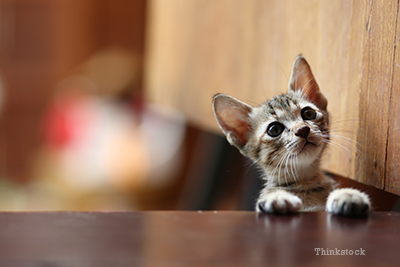
Feline Panleukopenia (sometimes referred to as feline distemper) is an extremely contagious and often fatal disease of cats. It can also infect non-domestic felidae and other animals such as raccoons and certain members of the weasel family such as mink. It does not affect dogs.
What are the causes of panleukopenia?
Feline panleukopenia is caused by a virus closely related to canine parvovirus infection (some strains of canine parvovirus can infect cats) and like parvovirus of dogs the virus can persist in the environment for a year or more. Once a commonly seen disease, panleukopenia is now relatively uncommon in large part because most domestic cats are vaccinated and the vaccine is very effective. Nonetheless, the disease persists among unvaccinated cats. As is the case with parvovirus in dogs, the feline form of the disease is transmitted in bodily fluids and can persist in the environment. Transmission (on shoes and clothing) and environmental contamination can be greatly reduced with simple hygiene1.
What are the signs of feline panleukopenia?
The disease occurs primarily in young cats and kittens and causes severe depression and lethargy as well as fever, vomiting and diarrhea. Affected cats may have a very low white blood cell count (hence the name panleukopenia). Many cats undergo a subclinical infection and do not show signs at all. Not all exposed cats become clinically ill but exposed cats as well as cats that survive the full-blown disease have long-term immunity after their infection.
How can cats become infected by feline panleukopenia?
The route of infection is primarily oronasal exposure to secretions or excretions or infected animals or environment. The virus quickly enters the blood stream and spreads to all parts of the body. The disease is frequently fatal with a mortality rate as high as 75 percent in untreated cats. Complete recovery can take several weeks2.
How is feline panleukopenia diagnosed?
A presumptive diagnosis can be made based on history and clinical signs as well as a very low white blood count. More sophisticated tests may be employed in large outbreaks but are not generally needed.
What are the treatments for feline panleukopenia?
Because this is a viral disease, treatment is largely based on the symptoms until the patient begins to recover and usually consists of, in severe cases, hospitalization for intravenous fluid therapy and antibiotics. The most severe symptoms occur in the first 5-7 days.
What is the prognosis with feline panleukopenia?
Though if untreated the disease can be fatal, early aggressive therapy is often successful. In cats that do survive, reinfection does not recur, ie, they have life long immunity.
How can feline panleukopenia be prevented?
There is a very effective and very safe vaccine available that has significantly reduced the incidence of panleukopenia. All cats should be vaccinated in accordance with the recommendations of the American Association of Feline Practitioners and your veterinarian.
As with many diseases the answer lies in early and complete prevention by means of effective vaccination procedures. Be sure to discuss this and other vaccine recommendations as part of your cats overall wellness program.
If you have any questions or concerns, you should always visit or call your veterinarian -- they are your best resource to ensure the health and well-being of your pets.
1. "Overview of Feline Panleukopenia." Merck Veterinary Manual. July 2013. Web.
